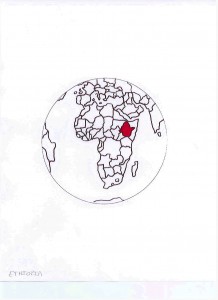ETHIOPIA
A. THE COUNTRY
The Federal Democratic Republic of Ethiopia is a landlocked country
located in the Horn of Africa. It is one of the oldest nations known,
with a democratic federal government since 1991, with power devolved to
ten regions. The economy is heavily based on agriculture (main export
is coffee) which depends on unreliable weather and on exhausted land
from 3000 years of cultivation. Underdevelopment is due to war, famine,
changing political systems, and frequent tensions with Eritrea and
Somalia. There is chronic malnutrition of millions, and AIDS is a major
scourge. Systemic dependence on foreign aid and food undermines the
work ethic and local agriculture. In the past few years there has been
increase in political stability, economic growth and job opportunities.
B. THE PEOPLE
The population is ~84,976,000, and 70% are under the age of 30.
The majority of the population are able to speak the official language,
Amharic. Other languages are official amongst the many ethnicities and
their respective regions. English is widely taught.
~41.5% are Semitic/Ethiopian, ~41.6% Cushitic, ~14.7% Omotic,
~1% Nilotic, ~1.2% Other.
C. RELIGIONS AND CHRISTIANITY/PENTECOSTALISM
North Ethiopia was one of the first Christian nations – from the 4th
Century. The Ethiopian Orthodox Church was the state church from 1270
until Marxist government takeover in 1974. Since 1991, there has again
been freedom for worship and witness.
~60.68% claim to be Christian, ~34.1% Muslim, ~3.7% Ethnoreligionist,
~1.5% Non-religious, ~0.02% Baha’i.
In the Christian category:
~39.52% are Orthodox, ~17.54% Protestants, ~1.66% Independent, ~1.21%
Unaffiliated, ~0.72% Catholic, <0.01% Anglican, and other groups ~0.03%.
There has been great growth of Evangelicals in the last 20 years to
~19.6% of the population. ~10.3% of the population are Charismatics and
of those, ~2.7% are Pentecostals.
Donna Siemens
References:
http://en.wikipedia.org
Operation World, Jason Mandryk. Colorado Springs: Biblica Publishing, 2010.

